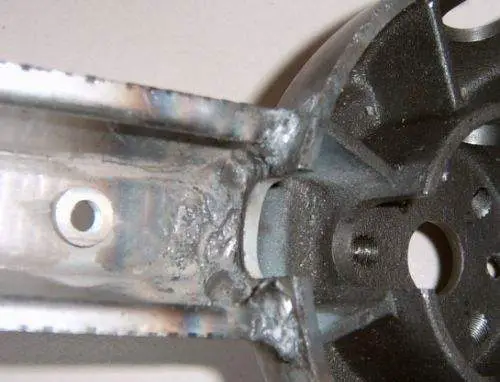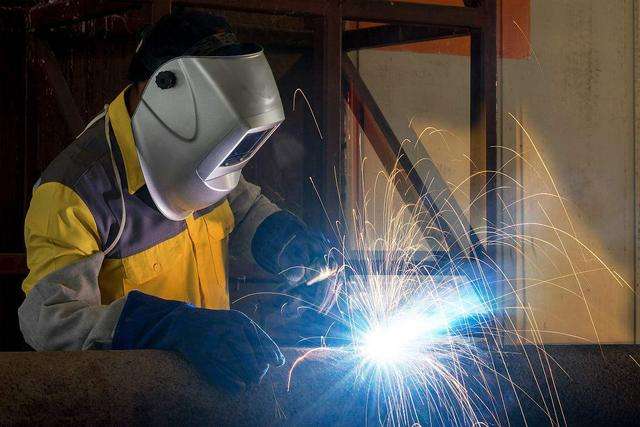Many people have doubts about the possibility of welding cast iron. They are unsure whether cast iron can actually be welded, as well as the methods that can be used and the precautions that must be taken.
Related Reading: 7 Types of Iron Castings You Should Know

Let's discuss the methods and precautions for welding cast iron and how to select welding rods.
Related Reading: How to Choose the Right Welding Rod?
What is cast iron?
Cast iron refers to items produced by smelting cast iron.
Although cast iron has lower strength and plasticity compared to steel, it has excellent abrasiveness, shock absorption, castability and machinability.
Due to the simplicity of manufacturing equipment and low production costs, it is often used for the production of large machine components such as cases, hulls, fuselages and bases.
Some crucial parts with minimal impact, such as the crankshaft of small diesel engines, are made from ductile iron.
However, the poor weldability of cast iron restricts its use in welded structures.
Currently, cast iron welding is primarily for repair and maintenance, with very few use cases for creating composite parts.

Iron castings are prone to defects such as air holes, pinholes, slag inclusions, cracks and pits due to various factors.
Commonly used repair equipment includes argon arc welding machines, resistance welding machines and cold welding machines.
For casting defects with low quality and appearance requirements, argon arc welding machines and other welding machines that generate high heat and speed can be used for repair.
Related Reading: 10 Different Types of Casting Process

Can iron castings be welded?
Cast iron can be welded, but its weldability is poor.
Cast iron refers to articles cast with cast iron. Unfortunately, several factors can lead to defects, such as air holes, pinholes, slag inclusions, cracks and holes. These defects can affect the appearance quality, internal quality and usability of cast iron.

Appearance quality refers to various factors that affect the surface roughness, surface defects, size deviation, shape deviation and weight deviation of castings.
It mainly includes the metallographic structure of the casting and the presence of holes, cracks, inclusions and segregations in the casting.
Service quality refers to the durability of cast iron under different working conditions, including wear resistance, corrosion resistance, cold and heat resistance, fatigue, shock absorption and other properties, as well as machinability, weldability and other process properties.
Due to different factors, iron castings may have defects such as air holes, holes, slag inclusions, cracks and pits.
Commonly used repair equipment includes argon arc welding machines, resistance welding machines and cold welding machines.
To repair casting defects with low appearance and quality requirements, high-temperature and high-speed welding machines such as argon arc welding machines can be used.

The quality of cast iron has a great influence on the performance of mechanical products.
For example, the wear resistance and dimensional stability of machine tool castings have a direct impact on the accuracy and maintenance life of machine tools.
Likewise, the size, profile accuracy and surface roughness of impellers, casings and internal cavities of hydraulic parts in various pumps significantly influence the working efficiency, energy consumption and cavitation development of pumps and hydraulic systems.
Furthermore, the strength and thermal shock resistance of cast copper parts such as cylinder blocks, cylinder heads, cylinder liners, piston rings and exhaust pipes of internal combustion engines have a direct impact on the service life of the motor.
Cast iron welding type
The common welding of cast iron is divided into hot welding and cold welding.

The hot welding method for welding cast iron involves preheating the casting to a temperature of 500 to 600 ℃. For this method, Z248 cast iron core welding rod or Z208 steel core welding rod is typically used, resulting in a weld that is similar in composition to cast iron and therefore homogeneous.
However, preheating is not necessary for cold welding of cast iron, and pure nickel electrode Z308 or iron-nickel electrode Z408 is generally used for this method. The composition of the resulting weld is different from that of cast iron and therefore heterogeneous.
During welding, it is important to polish the welding surface to avoid impurities and ensure a firm surface after welding.
How to weld cast iron?
Welding iron castings is possible, however, weldability is usually poor and presents difficulties.
It is typically not recommended to repair cast iron through welding.

For minor appearance defects without any voltage requirements, they can be corrected by using Z308 welding rod and manual arc welding. However, it is necessary to use a hammer to continuously tap after welding to remove residual stress and prevent cracking.
In case of larger defects, welding with oxyacetylene gas can be used. The welding material should be cast iron bar of the same material as the casting and borax should be used as flux. Preheating is essential before welding, with the temperature set between 850-900°C.
After welding, heat treatment is required, which can be quite complicated. However, repair welding is not permitted for major live components. The welding technique adopted depends on several factors such as material, size, thickness, complexity, type and size of the defect, cutting process and technical requirements of the casting.
Related Reading: Welding Basics You Should Know
To meet various welding requirements, it is important to prepare in advance by removing oil stains and sand inclusions, chamfering or preheating.
Available welding methods include gas welding, brazing, manual arc welding, and manual electroslag welding.
Gas welding, in particular, is classified into three types: hot welding, heating stress relief zone method, and gas welding without preheating.

Manual arc welding is divided into cold welding, semi-hot welding, welding without preheating and hot welding.
1. Welding of gray cast iron
Gray cast iron contains high levels of carbon, sulfur, phosphorus and other impurities. It has low tensile strength, brittleness and very little plastic deformation capacity, which ultimately leads to poor welding performance.
The main problem with welding gray cast iron is the susceptibility to the formation of white, hardened structures along with cracks in the welded joint.

Welding gray cast iron can result in the formation of a white molten structure in both the weld metal and the heat affected zone. This result depends on the welding materials used during the welding process and the cooling rate after welding.
Related reading: 8 problems when welding different materials
Preheating, heat preservation and slow cooling are effective measures to reduce and prevent white spots during welding.
For homogeneous welding, preheating between 400-700 ℃ can generally prevent the formation of white spots on the weld and fusion zone.
When heterogeneous welding is used, it is typically performed at room temperature without preheating the welding, which makes it difficult to completely avoid the formation of white spots in the fusion zone.
However, the generation of white spots can be reduced by using low-temperature preheating, post-weld heat preservation, and slow cooling.
2. Gray cast iron welding process

Welding cast iron can be a challenging task due to its hardness. However, with proper welding methods and materials, success can be achieved. Furthermore, a set of suitable welding process measures is required to cooperate with the welding repair process.
Related Reading: How to Choose Welding Materials for Stainless Steel?
There are several common methods for welding gray cast iron, including arc welding and gas welding, as well as brazing and manual electroslag welding.
Arc welding is the most used method, with arc welding with electrodes being the most common. Gas shielded welding, on the other hand, is used less frequently.
Welding cracks in cast iron are caused by the low strength and low plasticity of the material, as well as welding stresses.
Therefore, the prevention of welding cracks mainly involves reducing or eliminating welding stress.
In practice, there are several methods for arc welding repair, including cold welding, hot welding, semi-hot welding and welding without preheating. Gas welding methods include hot welding, heated stress relief zone, and welding without preheating.
By using these welding methods effectively and reasonably, good results can be achieved.
Causes of specific difficulties in welding repair of cast iron and corresponding solutions
It is easy to form a white point structure, mainly caused by the fast cooling rate of the weld and the lack of graphitization elements.
Solution :
The. To obtain optimal results, it is recommended to adjust the chemical composition of the weld by increasing the darkening element and selecting an appropriate welding rod.
B. To avoid cracking and improve darkening conditions, it is suggested to reduce the weld cooling rate. This can be achieved by preheating before welding and using a slow cooling process after welding.
w. The brazing method is preferred for welding repairs because it prevents melting of the cast iron.
② Note: Cast iron has high carbon content, low strength, low plasticity and is prone to shrinkage. As a result, it is susceptible to cracking and even peeling under welding stress after cooling.
Solution :
The. Adopt thermal welding method;
B. Heating stress relief zone method;
w. Cold arc welding method;
d. Gas shielded welding (thin wire commonly used CO 2 shielded welding);
It is. Take special technological measures, such as planting silk.
③ Pores are easy to form in cast iron welds, mainly due to the rapid cooling rate and small semi-melting range. This often results in insufficient time for the gas present in the molten pool to escape, leading to the formation of pores.
Solution :
The. Clean carefully before welding;
B. Adopt thermal welding method;
w. Select the welding rod reasonably.
④ Poor weld formation is mainly caused by silicon oxide film that is difficult to melt when cast iron is welded, which will reduce the fluidity of the molten metal and make it difficult to obtain beautiful welds.
Solution :
The. Select welding materials with good fusibility with cast iron;
B. Select reasonable welding parameters;
w. Gradually improve operational skills.
























































